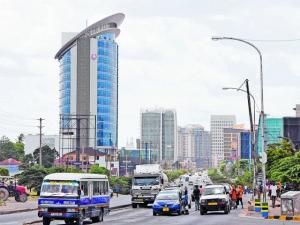
Is Dar es Salaam prepared for emergency climate response?
In the Conference of the Parties to the UN Framework Convention on Climate Change (COP 26) last year, it was agreed that actions to meet the global goal of carbon neutrality by mid-century should be concentrated in cities, as they are responsible for nearly 70 percent of global greenhouse gas emissions.
In Tanzania, in terms of the top three in magnitude of emission, carbon dioxide is in the lead, followed by methane and nitrous oxide. These are primarily from the National Bureau of Statistics’ (NBS) sectoral category of land use, land-use change, and forestry (LULUCF), and they account for roughly two-thirds of total emissions in the country.
Globally, the climate emergency is a defining challenge of our time, and we as a country are not excluded. In 2021, North America and the Mediterranean region experienced heat waves and wildfires, Europe, China, and East Africa had torrential rainfall and flooding; and droughts troubled parts of Latin America.
Over the years, we have had severe floods in places like Dar es Salaam, Kilosa, Mpwapwa, and Kilombero. We have also seen some islands, such as Pangani and Fuvu la Nyani in Rufiji, submerging owing to the rise of sea level (Ref. National Bureau of Statistics, National Climate Change Statistics Report, 2019—Tanzania Mainland, page 3). This is to show us that climate change is an emergency, it is real, and it is not far away from us.
According to the World Population Review (2022), Dar es Salaam is among the fastest growing cities in Africa. It is the third-fastest growing city in Africa, and the ninth in the world. With a large population and industries, there is a high emission of greenhouse gases, which contributes to global warming and the disastrous extreme weather conditions that later become climatic changes.
Vulnerability vs transitioning
More than 11,000 cities have taken steps towards the agreed action to reduce emissions of greenhouse gases in building and construction, transport, energy, and waste management. This is done by making urban infrastructure resilient and by using practical, healthy, and efficient means of environmental conservation. A research project by ICLEI—Local Government for Sustainability—in Africa titled “Sub-Saharan African Cities: A Five-City Network to Pioneer Climate Adaptation through Participatory Research and Local Action” featured Namibia, South Africa, Mozambique, Tanzania, and Mauritius. In it was the title, “Climate Change Projection for Dar es Salaam: Adding Value through Downscaling.”
The research highlights the city’s vulnerability and foresees the time when climatic changes will overwhelm the carrying capacity of the city’s infrastructure and services. The rise of sea level affects water and sanitation, transportation, and health; damages infrastructure, harbour, and sea walls, and increases demand for electricity.
In an effort to support the most vulnerable communities in being alert and recognizing that climate change can aggravate displacement and increasingly contribute to migration to urban areas, awareness programmes have been carried out at local, regional, and global levels. This is in response to the results of periodic risk assessments, to warn people about the impact of climate change on the rise of sea levels and the devastation it will cause.
Comparative glance
The 2022 population and housing census records by the National Bureau of Statistics (NBS) establish that Dar es Salaam is home to at least 5.38 million people, which amounts to 8.7 percent of the entire Tanzanian population. The United Nations Environmental programme (UNEP) warns that many of these residents are at risk because they are poor and live in this low-lying city surrounded by an ever-rising sea. The population of Dar es Salaam should not be taken for granted. At the moment, it is more than half the population of New York, USA, which is about 8.4 million; more than twice the population of Copenhagen, Denmark, which is about 2.5 million; and more-or-less equivalent to the population of Sydney, Australia.
Compared to Dar es Salaam, these massive coastal cities have much better adaptive infrastructure in the event of water disasters and weather variability emergencies. Atlantis may be a fictitious island lost to the sea, but for Dar es Salaam and hundreds of other coastal cities threatened by rising sea levels, Plato’s tale may prove to be a logical prophecy.
Meanwhile, it is not just the sea water that is rising. Intense rainfall is flooding neighbourhoods each year, eroding the foundations of buildings, and tainting clean water, which is widely used by the city’s households for drinking, cooking, and sanitation. Because of poor infrastructure, a lot of rain is a problem, and the absence of rain is an even bigger problem as water supply goes considerably low.
There is also a massive increase in the demand for water for domestic use due to the increase in population. According to the 2012 ICLEI five-city research, this increase was projected to rise by 970,000 cubic metres per day in 2020, when Dar es Salaam’s population would have risen to 6 million.
More so, carelessly managed sewage systems pollute the city, making its more populated settlements look like stinking landfills and a potential hub for disease, different from the beautiful ideal of a city full of air to breathe. The government needs to take new risks caused by climatic changes into consideration and adopt effective mechanisms to prevent escalation. We also need mechanisms to monitor and control the increase of population density in areas that are prone to the rise of sea level and flooding.
Controlling escalation
Accelerating the roll-out of the Resilient Settlements for the Urban Poor (RISE UP) Programme, aimed at responding to vulnerability in informal settlements and urban displacement areas in times of climate change, particularly extreme weather conditions, is one of UN-Habitat’s proposed responses to climatic change in cities.
However, in the bigger picture of Dar es Salaam, this adaptation seems not to have been produced effectively. Though in part, we must acknowledge the building of seawall, which protects the city’s coast. The climatic transitions occurring in the city demonstrate that the “Leave No One Behind” development flagship is an illusion, as settlement patterns and old sewage systems remain prevalent and there is no change.
Climate change events pose a risk not only to the infrastructure but also to the health and well-being of the residents. In its 2018 study report titled ‘Groundswell: Preparing for Internal Climate Migration, Projections for East Africa,’ the World Bank estimated that climate change will hit East Africa hard and there will be more than 10 million ‘climate migrants’ by 2050, with an increase in the rise of sea level and declining water availability in large swaths of coastal metropolises in Kenya and Tanzania. No change can be achieved without involving the people on the frontlines.
There has been national mobilization towards protecting communities and natural habitats, and restoring ecosystems, but more pragmatic approaches are needed to make life in the city safe. Investing in getting more young people’s voices and visions involved in these global dreams of a healthier climate, pollution cut down in cities, and conservation of nature is paramount.
With the pressure on young people to embrace self-employment, especially in cities where they struggle with the cost of living, involving them may prevent the possibility of them going into endeavours that pull down the global dreams to conserve and restore our Mother Nature.
Dar es Salaam is among the major production and trade hubs, and is thus among the most vulnerable places. Awareness programmes with groups and institutions, especially those at the front lines of the climate crisis, will help to curb what António Guterres, in his message on the launch of the United Nations Environment Programme Adaptation Gap Report, calls “the here-and-now impacts of the climate crisis” and prevent escalation.
https://www.thecitizen.co.tz/tanzania/news/national/is-dar-es-salaam-pre...
